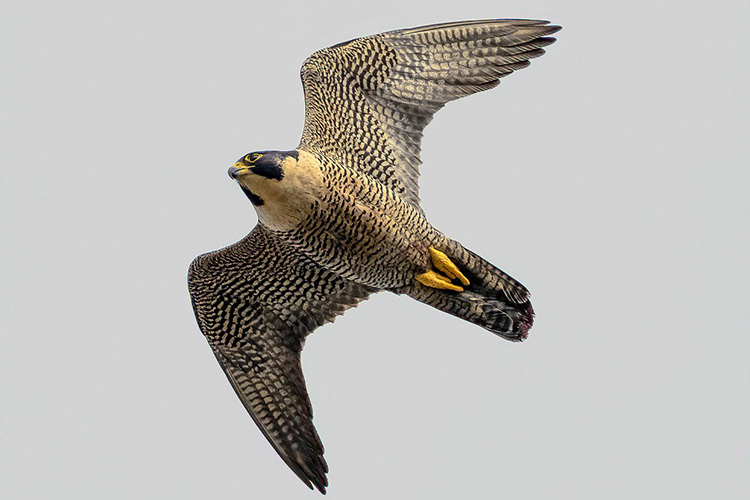
After months of drama for Berkeley hawk couple Annie and Grinnell, and questions about whether these eggs would hatch following Grinnell’s death on March 31, the dedicated care of Annie and her new mate, Alden, will hopefully produce three babies for next week. (California Falcons Image)
The long-awaited hatching of three peregrine falcon chicks atop the UC Berkeley Campanile begins on Friday, May 6. In celebration, the annual Hatching Day festivities, canceled for two years during the pandemic, will return with fun and educational activities on the South Side of the Valley. Life Sciences Building.
The outdoor event, hosted by Cal Falcons, will take place from 9 a.m. to 3 p.m. and will include the opportunity to see live footage of what’s happening at the nest, local falcon experts answering questions from visitors, and community projects. falcon related art.
“There will also be telescopes for people to look at, to see if they can see the falcons at the Campanile,” said Lia Keener, a senior on the Cal Falcons team. And with final exams looming next week, “we hope this little social event will help students relax,” said sophomore Yuerou Tang, who is also helping out with Hatch Day.
Then, at 3 pm, there will be a live Hatch Day Q&A on YouTube with Cal Falcons ornithologists Sean Peterson and Lynn Schofield.

Alden, Berkeley’s newest male peregrine, is distinguished by his injured left foot, which dangles when he flies, and his dark “chin strap” cap and tail. (Photo by Bridget Ahern)
Not all of the reddish-brown eggs may hatch on Friday, and some years one or more may not hatch at all, but that is the day the action is likely to begin. A clutch of peregrine falcon eggs typically hatch “about 48 hours from first egg to last, with more eggs toward the leading side of the hatching window,” Peterson said. “If they start hatching on Friday, we’ll pretty much know by Monday if any aren’t going to hatch.”
Schofield said: “We expect all the chicks to hatch sometime on day 6. Very early in the morning on day 6 is the most likely time for the first egg to hatch, based on previous years.”
Last year, triplets were born, two of them on Saturday, April 16 at 3 am and 12 noon and the other on Monday, April 19, just before 6 am, to falcon parents Annie and Grinnell; a fourth egg did not hatch. The pair started raising chicks at the bell tower in 2017 and together they produced 13 chicks. One, Lux, died while learning to fly.
This spring, Annie laid two eggs before Grinnell’s death on March 31. A third egg was laid two days after her death and its origin is unknown. Annie welcomed a new mate, Alden, to the nest just seven hours after Grinnell was struck by a vehicle in downtown Berkeley.

Enduring the death of her longtime mate Grinnell, the drones flying near her nest, and the lone hawks seeking to take over her territory, Annie has emerged strong and has mated once more, this time with a falcon that the public has called Alden. (Photo by Bridget Ahern)
Over the past few weeks, Peterson said, it’s been “smooth sailing” for the new couple. A few hawks on the loose who stopped by the tower to assess their chances of finding a new home or a new mate, but none have stayed long. Annie is incubating the eggs most of the time, and Alden is the main hunter of her food.
If the chicks hatch on Friday, they will be banded as part of ongoing research with the Santa Cruz Raptor Research Group. Bird banding is a formal program through the U.S. Fish and Wildlife Service that can reveal how long a bird lives and the movements between its birth and nesting sites, which a hawk typically chooses when is between 2 and 4 years old.
Peterson said feathers will be collected from chicks during banding and could be used to assess chick paternity as part of a broader effort to understand hawk relationships in the Bay Area.
By mid-June, the babies will have grown enough to try to fly.

Annie (left) and her new partner Alden look at the eggs Annie laid this spring. (California Falcons Image)
Public interest in the Berkeley Falcons has grown 20% in the past month, since Grinnell’s death and Alden’s arrival, according to Cal Falcons social media data. Initially, the group of biologists and volunteers expressed concern that the three eggs would not hatch at all, after Grinnell’s death, as Annie was unable to incubate them and forage for food from her.
But then Alden arrived and was greeted by Annie, who wasn’t expected to bond with a new partner, if she found one at all, for weeks. He immediately began to help her incubate her eggs and brought her food.
“It was a really compelling story for a lot of people,” Peterson said. He said that aside from the US, the top countries glued to Cal Falcons’ social media posts are Australia, Canada, Japan and Italy.
The public continues to share artwork, stories, videos and other materials commemorating Grinnell with the Cal Falcons, but “there’s a lot of interest in the new family,” he said. “Everyone is really looking for a happy ending for Annie and Alden.”
